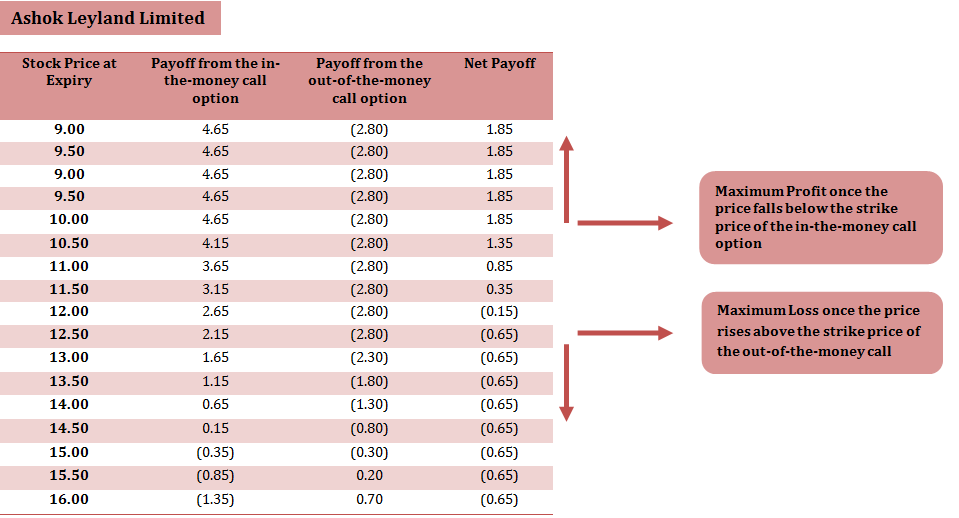When to use: Bear Call Spread Strategy is used when the investor believes that the stock price will fall in future or at best, it will remain range bound i.e. the investor is bearish on the stock.
How it works: In a bear call spread option the investor buys 1 out-of-the-money call options and sells 1 in-the-money call options of the same underlying stock for same expiry period. The aim is to collect a net premium. Typically, the premium collected on the call sold will be higher than the premium paid for buying the call. Since the investor is bearish on the stock, he would sell the call with a strike price closer to the current stock price (which will yield higher premium) as he hopes that the price will fall, and he will retain the premium. At the same time the call bought with the higher strike price acts as an insurance against a sharp rise in the stock price.
Note that this strategy may also be performed using 2 out-of-the-money call options. The concept would remain the same, i.e. make sure that you collect a net premium and that the premium you collect on the call sold is more than the premium you pay on the call bought (again, typically, this would happen when the strike price of the call bought is higher than the strike price of the call sold).
For example: On 2nd September 2013, the Ashok Leyland share was trading at Rs. 12, you sell an in-the-money call option with a strike price of Rs. 10 at a premium of Rs. 4.65 and simultaneously buy an out-of-the-money call options with a strike price of Rs. 12.50 at a premium of Rs. 2.80. Both calls expiring on 31st October 2013.
Risk/Reward: In the bear call spread option strategy, your maximum risk will be calculated by subtracting the net premium from the difference between the two strike prices (i.e. in our case by subtracting Rs. 1.85 from Rs. 2.50). An investor implementing this strategy is hoping for the price to settle below the lower strike price upon expiry which is when the maximum reward accrues i.e. the maximum reward in this strategy is to the extent of the net premium.
The table below shows the net payoff of the bear call spread option strategy at different spot prices on expiry:
(click to enlarge)
How to use the Bear Call Spread Option Strategy Excel calculator
Just enter your expected spot price on expiry, option strike price and the amount of premium, to estimate your net pay-off from the Bear Call Spread Option Strategy.
Note: The example and calculations are based assuming a single share though in reality options are based on lots of many shares. For example Ashok Leyland Limited call option contract is for 9,000 shares. Accordingly the net premium received will be Rs. 16,650 for 2 lots (i.e. Rs. 1.85*9000) in our example.
Also Note: Unlike the buyer of an option who only pays the premium to buy the option, the seller of an option must deposit a margin amount with the exchange. This is because he takes an unlimited risk as the stock price may rise to any level. In case the price rises sharply above the strike price, the exchange utilises the margin amount to make good the profit which the option buyer makes. The amount of margin is decided by the exchange and it typically ranges from 15 % to 60 % based on the volatility in the underlying stock and market conditions. In the above example, as a seller of call option, you will have to deposit a margin of Rs. 14,769.00 (i.e. Strike price * Lot size * 16.41%) for selling/writing a lot of Ashok Leyland Limited call option. Note that the total value of your outstanding position in this case will be Rs. 90,000 (i.e. strike price * lot size).



SIR,
IT WILL BE HELPFUL IF THE PAYOFF GRAPH IS PROVIDED FOR THIS LIKE OTHERS
Trading platforms for which brokers provide trading strategies in a way that the selected strategy is traded as a single order. For eg a bear call spread